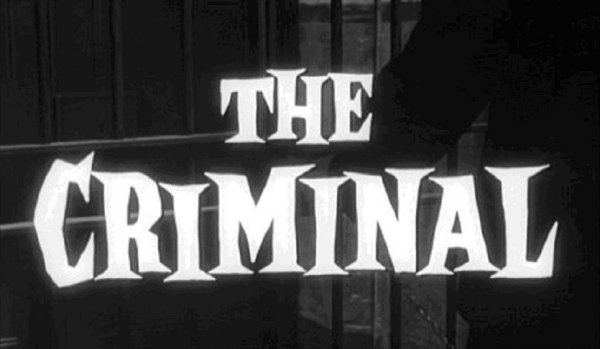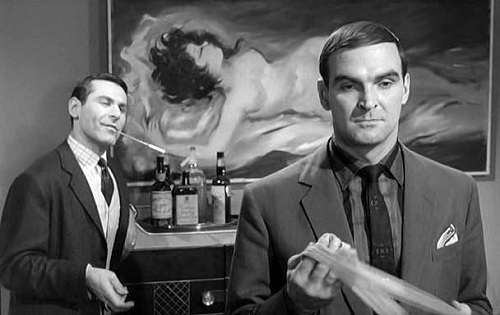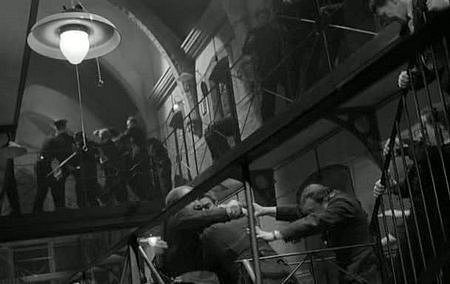

| |
The
Criminal (1960)
Country:
UK
Director: Joseph Losey
Merton Park Studios |
 |
|
AFTER
THE PARTY FREEDOM
WALK RIVERSIDE
STOMP TREASURE
DRIVE
John Dankworth And His Orchestra – Soundtrack Music From 'The Criminal'
Label:
EMI Columbia
Catalog#: SEG 8037
Format: Vinyl, 7", EP, Mono
Country: UK
Released: 1960
Genre: Jazz
Style: Soundtrack, Cool Jazz
Tracklist:
A1 Riverside Stomp
A2 Freedom Walk
B1 After The Party
B2 Treasure Drive
Credits:
Alto Saxophone – John
Dankworth
Alto Saxophone – Pete King
Baritone Saxophone – George Tyndale
Bass – Spike Heatley
Drums – Kenny Clare
Piano – Dudley Moore
Tenor Saxophone – Art Ellefson, Danny Moss
Trombone – Eddie Harvey, Ian McDougall, Tony Russell
Trumpet – Dickie Hawdon, Gus Galbraith, Kenny Wheeler
Tuba – Ron Snyder
Written-by – John Dankworth
Notes
Recorded on 1st and 5th July, 1960
Barcode and Other Identifiers
Matrix Number: 7TCA.1610
Matrix Number: 7TCA.1611
|
|
In
a recent post on They Made Me a Fugitive (1947), I cited that film
as a rare British example of American-style film noir. Joseph Losey's 1960
picture The Criminal (released in the US two years later under the
rather misleading title The Concrete Jungle) is another example of
a film noir made in Britain with genuine fidelity to the conventions of
the genre, although with some updating—it's more lurid and more sexually
explicit than earlier American examples of the genre—that brings it
closer to the spirit of the then-emerging Swinging Sixties. Losey was, of
course, actually an American with previous experience directing Hollywood
noirs (M, The Prowler, The Big Night), a refugee from
the film industry witch hunts of the early fifties. Relocating to Britain
and working at first under various pseudonyms, he continued his film
directing career as an expatriate until his death in 1984.
The Criminal opens with a shot of three men sitting around a table
playing poker with tense concentration. As they make their final bet of
7,000 pounds and lay down their cards, the camera draws back for a longer
shot—to reveal that the men are actually sitting in a prison cell and
the 7,000 pounds is really seven cigarettes. Almost immediately the credit
sequence begins, a two-minute long take of numerous prisoners and guards
and the roving camera performing an elaborately choreographed dance around
each other while the credits roll and on the soundtrack Cleo Laine sings
the mournful, bluesy theme song: "All my sadness, all my joy / Came
from loving a thieving boy." It's a remarkable opening which
announces unequivocally that this is going to be a film that uses image
and sound in ways which will keep us constantly surprised.
|
 |
 |
|
In the film Stanley Baker plays a career criminal named John Bannion who
is due to be released on parole the next day. During his three years
inside, he has been planning a racetrack robbery in meticulous detail.
Upon his release he reconnects with an old criminal crony, Mike Carter
(played by the American actor Sam Wanamaker, another refugee from the
Hollywood witch hunts), who helps him handpick a team to assist in the
heist. The evening of his release, Carter organizes a welcome home party
for Bannion, where he meets the sexy and seductive Suzanne (Margit Saad),
who throws herself at him, and soon he has fallen in love with her. The
robbery succeeds, and Bannion takes the stolen money to a field in the
countryside, where he buries it, planning to retrieve it to be laundered
after it has cooled off.
When Bannion makes the mistake of taking 500 pounds from the loot to buy
an engagement ring for Suzanne, this allows the police to trace the money
back to him, and he quickly finds himself back in prison. As soon as he
arrives, he begins to plan an escape so that he can make his way to the
loot, the escape to be covered by a riot engineered by Bannion's prison
friends to divert attention away from him. The riot and escape form a
stunningly conceived sequence, sensationally staged by Losey, photographed
by Robert Krasker (Carol Reed's Odd Man Out and The Third Man),
and scored by jazz composer John Dankworth. It's a good example of what
David Thomson identifies as the defining feature of Losey's early films,
the melding of the contradictory qualities of "subtlety" and
"hysteria"—subtle in its precisely controlled visual
choreography, hysterical in its typically flamboyant Losey touches and its
hyperkinetic sense of organized chaos.
|
|
|
|
|
|
|
The
screenplay, credited to Alun Owen (A Hard Day's Night) but
according to the British Film Institute actually a rewrite of a script by
veteran Hammer Films writer Jimmy Sangster, gives the film a tidy four-act
structure. The first and third parts—about half the film's running
time—take place in prison. In many ways these sections are an update of
the traditional Warner Brothers-style prison movies of the thirties. The
power structure of the inmates with Johnny as "top man," the
opposing alliances of prisoners enforced by violent intimidation, the
autocratic head guard, the weak prison warden—all the elements
associated with this type of movie are present, only depicted here with
even greater than usual emphasis on prison corruption and brutality. As
bleak as this prison world is, though, it's a world that is totally
ordered and self-regulated. The rules that govern it are understood, each
man has a defined place in its power hierarchy, and its concepts of
justice and ethics—as peculiar as they may be—are clear. At the same
time it's also a world whose sense of order allows for a certain amount of
individuality and fluidity within its social structure.
|
 |
|
One of the great ironies of The Criminal is that when Bannion
leaves prison, he finds in the criminal world outside its walls an even
more oppressive environment, and the film takes an unexpected turn from a
prison/heist movie to a movie about a loner battling the power elite (a
type of narrative strategy Losey would use with even more startling
results in his next film, the juvenile delinquent thriller turned sci-fi
chiller These Are the Damned). At this point the film noir ethos
really comes into play. Maybe Losey did in fact have a Marxist world view,
because what happens to Bannion outside prison could almost be considered
analogous to the plight of the individual worker in the face of a
monolithic power structure, here a criminal syndicate organized on
corporate principles. As Mike Carter warns Bannion at one point when he
attempts to rebel against the dictates of the higher-ups in the criminal
world, "Your sort doesn't fit into an organization. So we can't have
you running about messing things up, now can we, Johnny?" |
 |
|
An even greater irony is that while Bannion might believe he's in control
of his destiny, in this deterministic film noir universe the concept of
choice turns out to be largely illusory. It is only toward the end of the
film that he realizes he has been played and betrayed by the criminal
organization the whole way to get him to lead them to the money. Every
decision, every action he has taken has actually been preordained. Subtle
forces have been exerted on him to move him in a certain direction, and
his every reaction to these forces has been predicted and plotted in
advance. Bannion thinks he has been acting on his own initiative, but the
entire time since his release from prison, about twenty minutes into the
movie, he has been callously manipulated like a piece in a chess game.
If like Bannion you think there is any possibility of his overcoming the
odds against him, forget it. "Don't be a silly boy, John,"
Carter tells him smugly. "You can't win." And of course he's
right.
R.
D. Finch
- The
Movie Projector
http://www.themovieprojector.blogspot.co.uk |
| |
|


